Category Archives: News
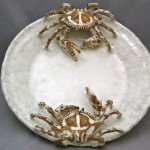
Ceramic Reef Art By Shayne Greco
This is not really aquarium related but it is kind of reef related and I thought it was rather neat. The ceramic art by Shayne Greco is good looking and made to be usable. I for one would love to have the octopus sink but would be afraid that it would break in shipping. The art is available in galleries around the nation and through his Etsy Shop.
Let us know what you think about this art by commenting below.
Thanks to advancedaquarist for bringing this to my attention.
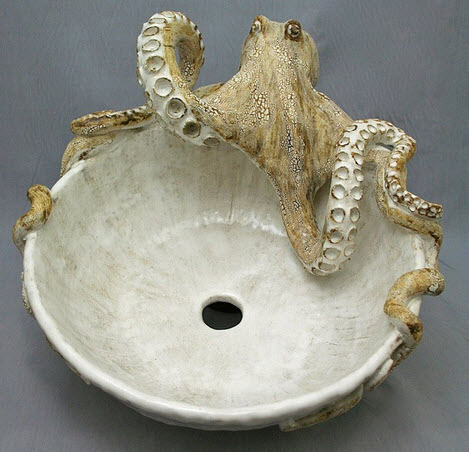
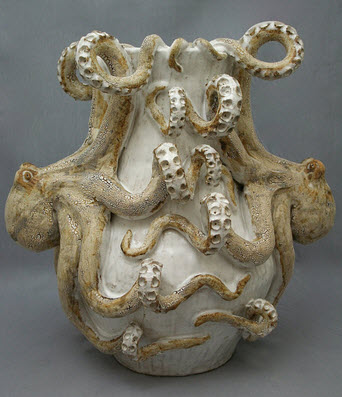
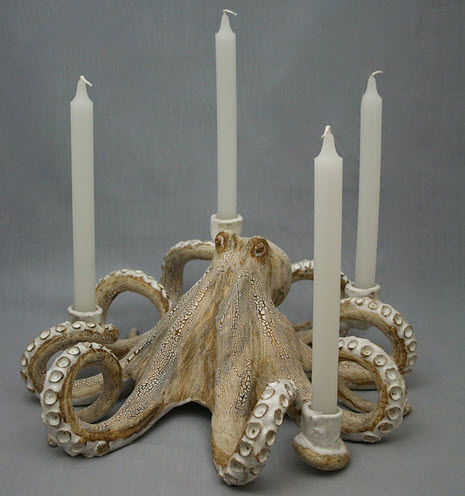
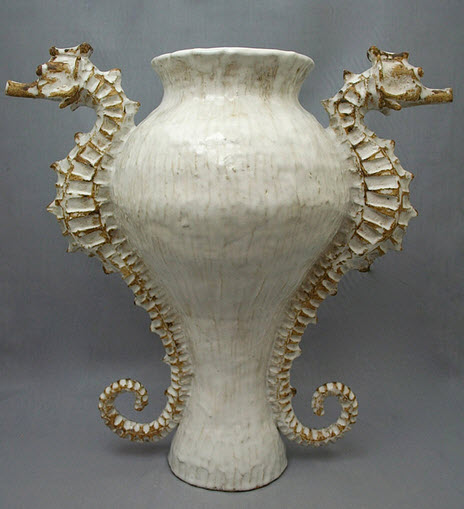


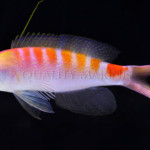
Unknown Anthias discovered in New Caledonia by fish collectors
Fish collectors in New Caledonia has found a species of Anthias previously unknown in the fish keeping hobby. The species has not been described scientifically and is thus without any scientific name. The collectors, working for marine fish wholesale importer Quality Marine, has dubbed the fish New Caledoina Sunrise Anthias as it is adorned with red-orange bars and hues of yellow and pink. Credit for first collecting this species goes to Antoine Teitelbaum, and credit for first seeing this species goes to Tony Nahacky.
“When first received by QM, we were unable to conclusively identify them as any of the known species,” Quality Marine explains in an official statement posted on their website. “Antoine and Tony reached out to a number of ichthyologists, some of whom have confirmed our suspicion that they are indeed a new species and are in the process of describing it for the scientific community.”
According to information provided by Quality Marine, the New Caledonia Sunrise Anthias is a deep water fish that forms large schools. Research indicates that the sex ratio within a school is 1:1. It is possible that the fish is endemic to New Caledonia. The New Caledonia Sunrise Anthia eats plankton just like other Anthias, and seems to chiefly feed on zooplankton and other meaty foods suspended in the currents.
Keeping The New Caledonia Sunrise Anthias in aquariums
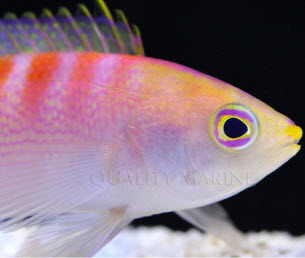
A cose up of the Caledonia Sunrise Anthias.
At Quality Marine, the collected New Caledonia Sunrise Anthias are currently being kept in two large schools. Dominant males and females can engage in some semi-violent behavior, but aside from this the school is peaceful.
“As a species, they seem to be less aggressive than many of the other Anthias this size. Because of our success in larger groups, they will likely be held like this in the future, and should be held in at least small groups (pairs, harems, etc) in the store display and home aquariums,” is the official advice provided by Quality Marine at this point.
As soon as the fish had acclimated, they started eating Nutramar OVA. After a day or so, they would also accept other meaty foods. They are now kept in on a diet of Nutramar OVA, enriched brine shrimp, Gamma mysis, krill, chopped prawn and other finely chopped meaty foods.
Probably a Pseudoanthias
Although the New Caledonia Sunrise Anthias has not be scientifically named yet, it can be tentatively placed in the genus Pseudoanthias. That would make it a close relative of species such as Sea Goldie (Pseudanthias squamipinnis), Bicolor Anthias (Bicolor anthias), Tiger Anthias ( Pseudanthias lori) and Two-spot Basslet (Pseudanthias bimaculatus).
The visual similarity between the New Caledonia Sunrise Anthias and other slender deep-water dwelling Pseudoanthias from the Pacific Ocean is easy to notice.
The New Caledonia Sunrise Anthias sports red vertical bars on the back, in a patter somewhat similar to the one displayed by Tiger Anthias ( Pseudanthias lori). The bars of the New Caledonia Sunrise Anthias are very wide and pronounced, and they reach halfway down the flank of the body. There is also a bright red saddle present at the base of the tail fin. Male specimens are normally more brilliantly colored than females, and males have a dorsal spine that proceeds far beyond the dorsal fin.
Buying New Caledonia Sunrise Anthias
Quality Marine will release the New Caledonia Sunrise Anthias on the aquarium market in the coming weeks. They do not sell directly to consumers, so fish keepers interested in keeping Sunrise Anthias need to contact marine fish stores and ask them to procure the fish for them.
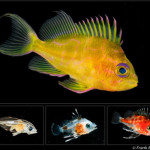
Hawaiian deepwater fish successfully reared from wild collected eggs
Odontanthias fuscipinnis, commonly known as Yellow Fin Anthias, is a much sought after deepwater fish endemic to the waters of Hawaii. It’s highly coveted by reef aquarists due to its striking coloration, and can cost $1 000 or more to procure.
In the future, captive raised Yellow Fin Anthias may start showing up in the trade, because marine fish expert Frank Baensch has now managed to rear wild collected eggs into nearly full grown fish in captivity. As far as we know, he is the first person to ever accomplish this feat. The species was reared as part of the Hawaii Larval Fish Project.
In December 2012, Baensch collected a small number of eggs from surface waters off Oahu and brought them to RCT Hawaii. When the eggs hatched, bright red larvae emerged.
“Features of the larvae include an elongated second dorsal spine and pelvic fin rays; pronounced head spination; brown pigment spots below the dorsal fin; and red pigment blotches on the body,” says the official blog of the Hawaii Larval Fish Project.
The larvae was kept in a 50 liter tank with multiple species and were fed wild caught Copepod nauplii plankton. According to Baensch, the larvae were robust in their 50 liter mixed species environment – good news for other marine aquarists interested in breeding or raising Yellow Fin Anthias.
As they matured over the course of 80 days, the larvae developed into small juvenile fish, lost their bright redness and started displaying the yellow coloration typical for adult Yellow Fin Anthias.
Odontanthias
Odontanthias is a genus of fishes in the subfamily Anthiinae in the family Serranidae. They inhabit rocky reefs and are found in deep waters; typically below 100 meters. A vast majority of the known species live in the Indo-Pacific, but Odontanthias hensleyi is native to the Caribbean
Just like other members of the subfamily Anthiinae, Odontanthias are planktivores with a peaceful temperament. They form schools in the wild and can be seen in large numbers above the reef while feeding. Since they are small to medium-sized, strikingly colored, non-aggressive and do not eat other fish, they have become much sought after by marine fish keepers.
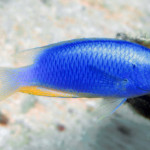
Pomacentrus micronesicus – new damselfish species from Micronesia
Picture above Courtesy of Jeanette Johnson. Liu et al. Zoological Studies 2013 52:6 doi:10.1186/1810-522X-52-6
Say hello to Pomacentrus micronesicus, a newly described species of blue damselfish! It has been given the name Pomacentrus micronesicus since is was found in Micronesia.
The new species was identified by Shang-Yin Vanson Liu (National Taiwan University), Hsuan-Ching Hans Ho (University of California) and Chang-Feng Dai (National Dong Hwa University). The full report “A new species of Pomacentrus (Actinopterygii: Pomacentridae) from Micronesia, with comments on its phylogenetic relationships” has been published by Zoological Studies and can be found here.
Cryptic species
There are plenty of known species of blue damselfish already, and now the Micronesian damselfish Pomacentrus micronesicus has been added to the mix. It looks very similar to several other species of blue damselfish, but the presence of only a light yellow coloration on the ventral fins and tail can help us a bit when it comes to distinguishing the Micronesian damselfish from other similar species of blue damselfish. There are also a few other things to look for, which you will find more information about further down on this page.
Marine organisms that look extremely similar but are actually genetically distinct are known as cryptic species. Thanks to new techniques for DNA sequencing, it has become possible for researchers to test if two similarly looking specimens are genetically distinct or not. This is what Vanson Liu, Hans Ho and Dai did to the fish they collected off the cost of the Marshall Islands, and this is how they were able to confirm that they had encountered a new species of damselfish.
Where does this species live?
The 21 specimens of Pomacentrus micronesicus collected for the study lived around the Marshall Islands in Micronesia, in the western Pacific Ocean.
The holotype was found near the Kwajalein Atoll (9°11′2.87″N, 167°25′4.88″E), at a dept of 5-10 meters. It was hand netted by Scott Johnson on August 2, 2009.
What does a Micronesian damselfish like?
No specimens longer than 30 mm has been found so far. Pomacentrus micronesicus is metallic blue both anteriorly and dorsally, with a light yellow ventral portion. The dorsal fin has the same metallic blue color, while the pectoral fin (including the soft ray of the pectoral fin) is of a light blue shade. The pelvic fin is light blue to yellow, with a blue anterior margin. The anal fin is also light blue to yellow, and has a blue margin, but is in addition to this adorned with small blue spots. The caudal fin is light blue to yellowish, with a few blue spots on the anterior portion.
Pomacentrus micronesicus has a deeply forked caudal fin with a relatively long filamentous upper lobe. The body is ovate and slightly elongated. The mouth is terminal, small and oblique and forms an angle of about 40° to 60° to the horizontal axis of the head and body.
How can I distinguish between Pomacentrus micronesicus and Pomacentrus colestis?
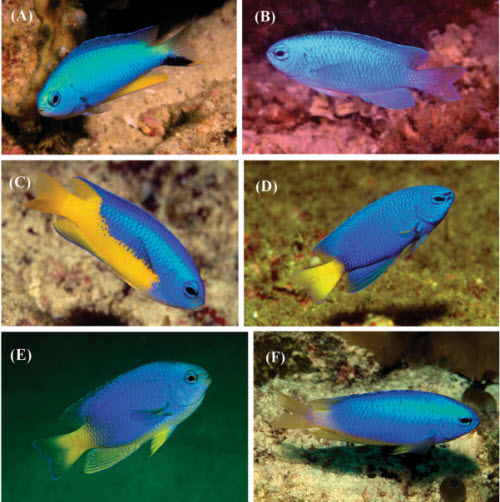
Photographs of the P. coelestis complex. (A) P. alleni, Weh Island, Sumatra, Indonesia. (B)P. coelestis, Nusa Kode, Komodo Islands, Indonesia. (C)P. auriventris, Raja Ampat Islands, Indonesia. (D)P. similis, Mergui Archipelago, Myanmar. (E)P. caeruleus, Andavadoaka, southwestern Madagascar. (F)P. micronesicus sp. nov., Chuuk, Federated States of Micronesia. Courtesy of GR Allen.
Liu et al. Zoological Studies 2013 52:6 doi:10.1186/1810-522X-52-6
P. micronesicus and P. colestis looks very similar to each other, but there are a few differences that can be useful for the reef aquarium keeper.
- Pomacentrus micronesicus tend to have a lower body depth than Pomacentrus colestis.
- Pomacentrus micronesicus usually has 15 rays on the anal fin while Pomacentrus colestis usually has just 14 rays.
- Pomacentrus micronesicus has 15 or 16 rakers on the lower limb of the first gill arch. Pomacentrus colestis has 13-14 rakers.
- Pomacentrus micronesicus has a total of 20-23 gill rakers on the first gill arch. Pomacentrus colestis only has 18-21 rakers.
- Look at the caudal fin of your fish. Pomacentrus micronesicus usually has a filamentous upper lobe that is deeply concave. Although this can occur in Pomacentrus colestis too, it is much less common.
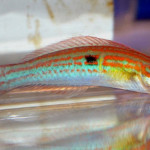
Minute wrasse – Minilabrus striatus – new species available at ACI Aquaculture
The Minute wrasse is a small colorful wrasse that can reach 2.5 inches / 6 cm in length. It is the only species in its genus and its small size makes it a perfect fit for small marine aquariums and marine aquarium with sensitive invertebrates in them. The species is reef safe but can eat small invertebrates. It should not be kept with larger fish. The Minute wrasse is a schooling species and should as such never be kept alone. It originates from the south and central parts of the red sea.
The minute wrasse that is now available at ACI Aquaculture is very rare in the aquarium trade and this might be the first time it has been imported to the USA. This is a shame since it is a stunning little gem that would make a wonderful addition to our aquariums.
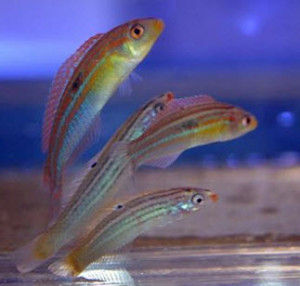 The species is according to my own observations plentiful in the wild in the red sea and the population should support a more widespread harvesting for the aquarium trade if it were to become a more popular species. In the red sea it lives in shallow waters, usually less than 36 ft / 12 meters deep. They are usually found in large groups at reef slopes. They are prominently found on the outher reef slopes but can from my observations be found anywhere on the reef where there is a drop of point. They are usually especially plentiful near caves at the outer reef slopes.
The species is according to my own observations plentiful in the wild in the red sea and the population should support a more widespread harvesting for the aquarium trade if it were to become a more popular species. In the red sea it lives in shallow waters, usually less than 36 ft / 12 meters deep. They are usually found in large groups at reef slopes. They are prominently found on the outher reef slopes but can from my observations be found anywhere on the reef where there is a drop of point. They are usually especially plentiful near caves at the outer reef slopes.
This species is as earlier mention best kept in groups but due to the limited numbers that have been collected and brought to the USA at this time it will be virtually impossible and cost prohibitive to to get a whole group. We would despite this like to recommend that anyone who is interested in this fish get at least 2 or 3. You will enjoy them a lot more and it also raises the possibility of breeding this species. Captive breeding on this species is highly desirable since it could make an excellent addition to our hobby.

Interesting Blog Articles
I found a few more articles that I found very interesting so I thought I would post links to them here

Interesting Blog Articles
I really do enjoy it when I have time for a lot of reading about the hobby. Below are some articles that I found interesting and I thought I would share them here.

Tap Water or RO Water, What’s the Big Deal ???
As most people have already learned, the key to any type of successful marine aquarium is to obtain the best water parameters possible and to keep these parameters stable. When referring to marine aquariums, I am speaking of both reef and FOWLR (Fish Only With Live Rock) style aquariums. The reason being is that most of the marine fish that we keep are wild caught and come from (or near) a coral reef and therefore would need the same water parameters as a reef tank if they are to thrive and remain healthy over the long term.
Just like the key to cooking a good tasting meal is to use the good quality ingredients, the key to maintaining good water quality in your marine aquarium starts by using good quality water.
Continue reading
Lightning clownfish fry
It is a big day for all clownfish lovers and especially those who hope to keep a lightning clownfish sometimes in the future. Not too long ago we reported on what ultimately turned out to be a failed spawning of the Lightning clownfish. Well a few days ago the pair spawned again and this time they didn’t eat their eggs. A few hours ago the first eggs hatched and the remaining ones where moved to a dedicated Black Round Tub for artificial hatching. There are still some challenges before we get to see lightning clownfish fry and there is no guarantee that the pair will produce Lightning clownfish fry but with a little bit of luck we will see lightning patterned fry before we know it that can be passed on to other breeders that can help this wonderful type of PNG clownfish spread in the hobby.
Go to lightning-maroon-clownfish.com/ for the latest news about the fry and the breeding efforts. You can see the hatching announcement here.
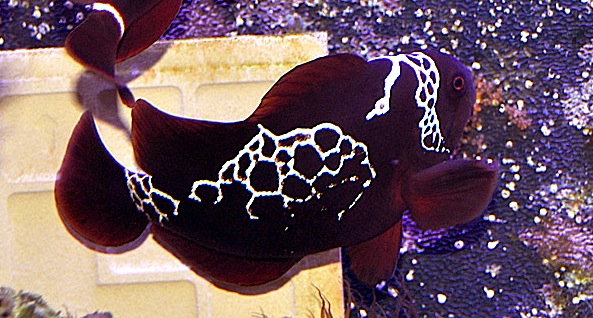
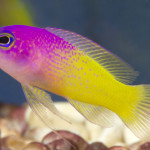
Bicolor basslet, Lipogramma klayi, bred by Todd Gardner
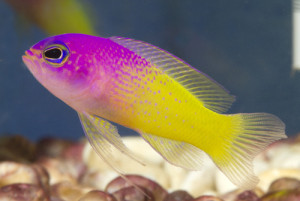 Todd Gardner at the Long Island Aquarium has added another first to the long list of species that was first bred at the aquarium. Todd successfully breeds and raised the larvae of the expensive deep water bicolor basslet, Lipogramma klayi. The stunning fish has been dropping in price over the last few years and can now be bought for under USD1000.This is in large part due to the Curacao Aquarium Submarine being able to catch them in larger numbers than before. It is however far from a cheap fish and there is no doubt that aquaculture of this fish is a worthwhile goal as more aquarists deserves to get to know this little beauty. Continue reading
Todd Gardner at the Long Island Aquarium has added another first to the long list of species that was first bred at the aquarium. Todd successfully breeds and raised the larvae of the expensive deep water bicolor basslet, Lipogramma klayi. The stunning fish has been dropping in price over the last few years and can now be bought for under USD1000.This is in large part due to the Curacao Aquarium Submarine being able to catch them in larger numbers than before. It is however far from a cheap fish and there is no doubt that aquaculture of this fish is a worthwhile goal as more aquarists deserves to get to know this little beauty. Continue reading